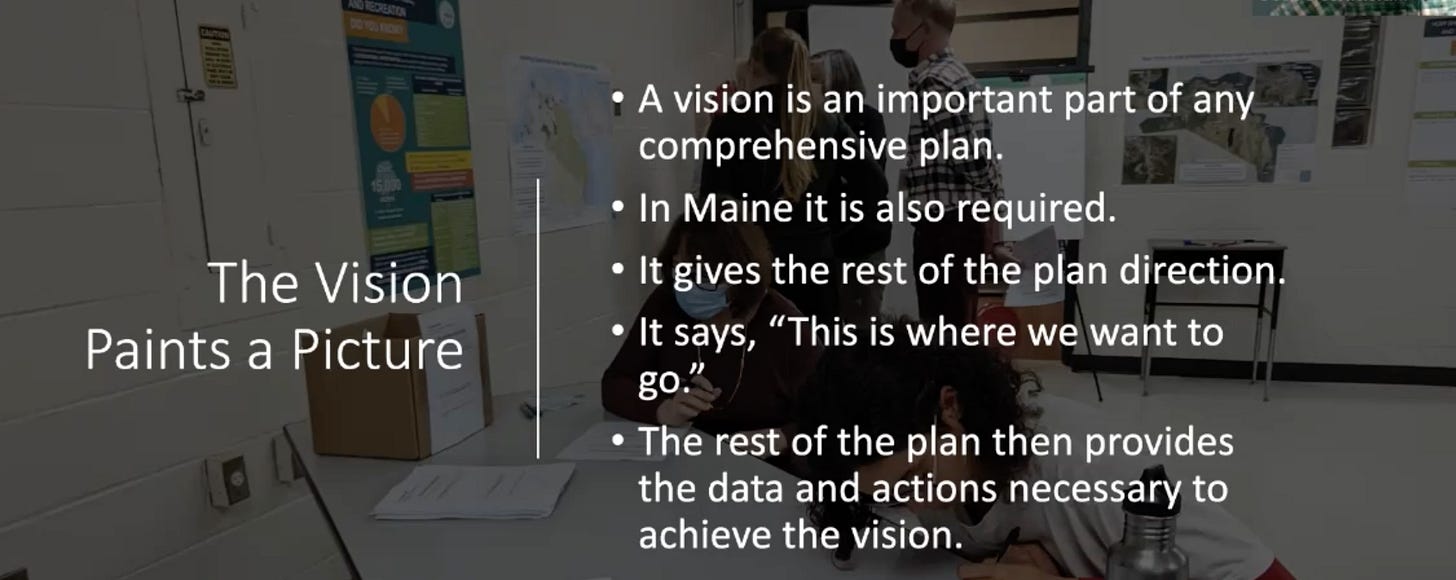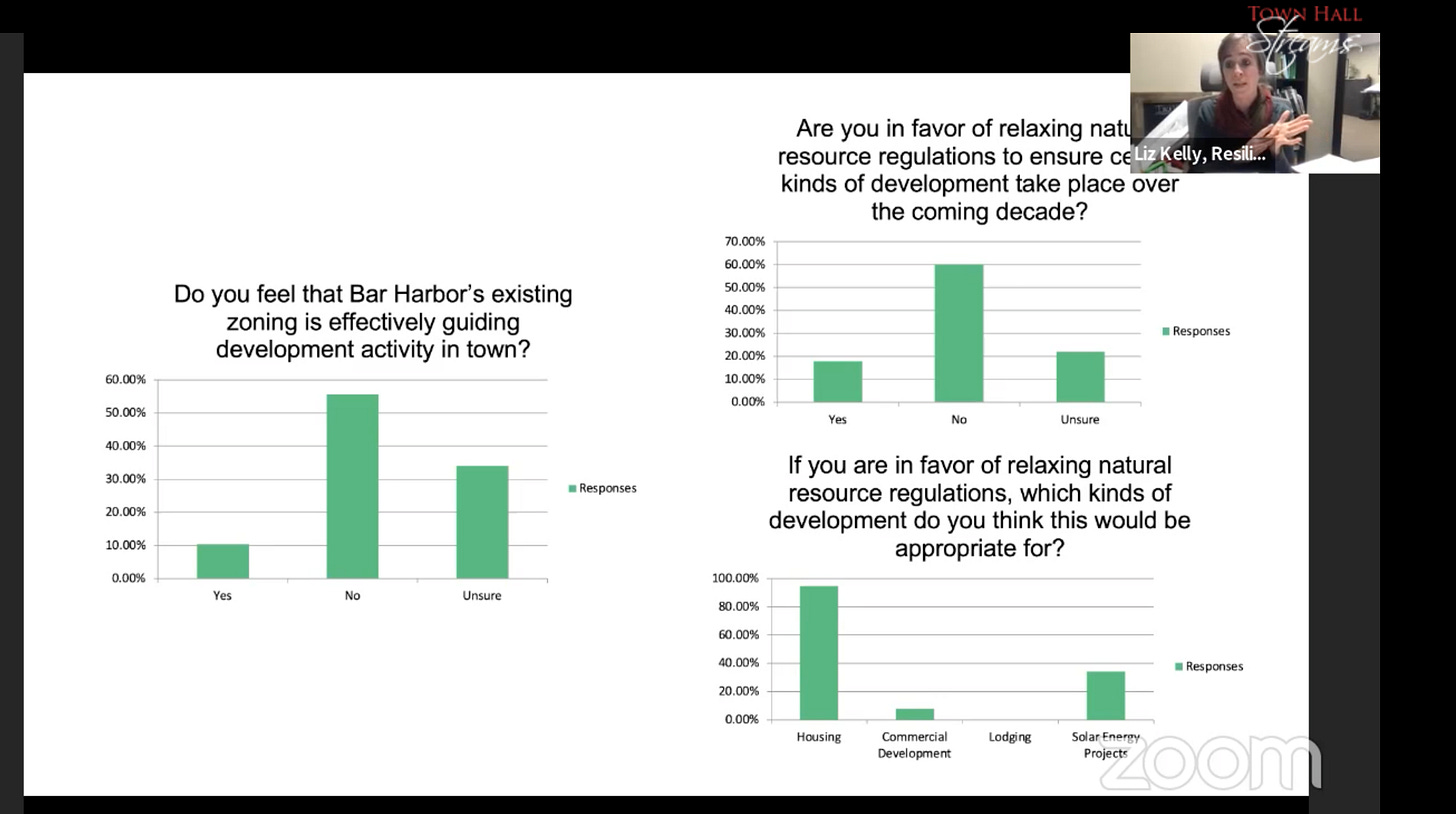"Staggering" Amount of Respondents Believe That Bar Harbor Isn’t Meeting the Needs of Its Community Members
Initial Findings from Comprehensive Plan Committee Public Forums Discussed
BAR HARBOR—What makes a town’s identity? It’s defining characteristic? What is it that a town is nostalgic for? And what does it want to become?
Those were all questions that were addressed near the end of a two-hour Comprehensive Planning Committee meeting on Thursday, December 14. The meeting was in person, on Zoom, and streamed and featured input by Resilience Planning Group’s (RPG) Steve Whitman and Liz Kelly. The company is helping guide the town in the creation of its newest comprehensive plan. The last was in 2007.
THE VISION
A portion of the meeting set the stage for the vision of the comprehensive plan. The vision is meant to communicate the consensus of the community as it paints a picture of the community’s future and is required by state law.
The last vision “Bar Harbor 2020” was in the 2007 Comprehensive Plan. Whitman gave the committee members an assignment for January 4 to read that last vision.
“This is so we can get your reaction to how that vision was framed and the topics and focus of that vision,” Whitman said. RPG will use what the committee says, the existing conditions report information, and public feedback from forums and an online survey to create a new draft vision for the committee to start working on in January.
Whitman suggested members look out a decade or more and envision the community in that 2035 time frame. You want to set a high bar, he said.
Whitma said the last comprehensive plan was well written and has a lot of the same discussions and issues except for housing. “I think you’ve had a lot of emerging themes that have become a lot more clear and dire,” Whitman said of the last vision statement. When done crafting the vision and plan, the committee members and community should be excited and say that’s the direction we need to go, he said. It should resonate.
That vision won’t be completed at the January meeting, but will be worked on. The committee will ask for more funding from the Town Council on Tuesday to continue the process an additional year. The extension of the members’ commitment in the process would also be an additional 12 months more than the initial 12 months of service.
“You’ve made such an effort to make the public feel involved,” Planning Board member Ruth Eveland said during the second public comment of the meeting. “The way to keep them involved is to keep them informed.”
She said that if the committee can show how Bar Harbor is different and special and how it is distinct from others, it would be beneficial to everyone.
“What it is that makes us us?” she asked, adding that if we know that then it can also help the town when engaging in conversation with neighboring communities. Understanding what the town can offer to the larger island community is also important while the town also attends to its own specific needs is an important balance, she said.
Committee Chair Kyle Shank said that he works in other communities and often hears the refrain of “We’re not Bar Harbor.” That sentence is often expressed as the defining characteristic of other towns.
Town Planner Michele Gagnon actually asked what people meant by that statement when she heard it said during a meeting, and she said that it seemed that this sentiment was all focused on the downtown portion of town. She agreed with Eveland’s assessment of the balancing of needs.
“We stand to all gain and prosper if we work together,” she said especially about housing and employment and the economy and livelihoods of the people on Mount Desert Island. The short-term rental restrictions in Bar Harbor had ripple effects into other communities, she said, adding that regional coordination is essential when leading conversations about those topics. How to initiate that and organize it is important, as is making sure that Bar Harbor comes to the table as an equal partner, she said, not a dominating one because the town has more staff and regulations.
“The future of the island depends on it,” she said.
Town Council Chair Valerie Peacock asked what was it about the Bar Harbor of twenty years ago that people are nostalgic for, and what was it about that time that people miss and how can the town bring that element into the future without going backward.
When a large portion of a town moves into another town, they bring expectations, Shank said.
INITIAL FINDINGS FROM THE COMMUNITY FORUMS
Kelly presented the initial findings from the Comprehensive Planning Committee’s public forums and the online survey.
They are still in the process of analyzing some of the information. They received 188 complete sets of responses. That 188 number doesn’t signify the total number of respondents because some people responded to one portion of the survey and not others.
One of the initial findings found that 94 percent of those who responded feel that the needs of segments of the community are being overlooked. What those segments were was not broken down at the meeting.
“That’s a staggeringly high number,” Kelly said.
Within the survey answers and the forum input, there are a lot of opinions, anecdotes and personal stories as well as specific feedback. “There were a substantial amount of comments” about town zoning allowing different housing types, Kelly said.
Kelly added that transportation improvements support bike and pedestrian transportation.
The initial findings also show that community members perceive multiple issues as barriers to economic growth and development.
“It’s good to hear what’s coming up with community members in response to these questions,” Kelly said. RSG plans to deliver a full report in advance of the committee’s January 11 meeting.
Translating what people are saying and translating that into goals and then into policy, means that the comp plan has to be clear and not vague or wishy-washy, Peacock said. “It is hard work to do this. We have to do it. It’s super important.”
Gagnon said that this is a fascinating community that is not like any other community and the comprehensive plan is meant to guide the community for the next ten years. But what is it that Bar Harbor really needs to focus on in the next ten years, she asked. She added that if the committee or town tries to do everything, it will result in arguments and doing nothing. She said that she would rather have a plan that creates a ten-year vision, but the committee has to make the top priorities that are truly meaningful.
Sustainability Coordinator Laura Berry spoke of framing the comprehensive plan on intersecting solutions as a guide of how to address these things. Everything will end up impacting other pieces, she said.
RPG wants to dig a bit deeper into new data so that the committee can focus the direction of the comprehensive plan. There is already a vast amount of public input that they’ve collected, Whitman told the committee.
Whitman said that according to the State of Maine and the pending housing analysis, if Bar Harbor keeps growing the way that it has by 2038, it will need an additional 385-400 housing units. The Polco data from the housing surveys might make that number even higher. He asked if that can be accommodated or is it beyond the scope of reality?
Peacock discussed whether they should look at the representation on the committee and where groups might be lacking and making sure the committee runs things by focus groups of people who are not committee members because of confirmation bias. That way, those visions, future land use plans, and actions will be more of a dialogue than a presentation when shown to the public, she said.
Gagnon said that staff will continue to engage renters and youth and wants to make sure that future generations see themselves in that plan.
UPDATE ON HOUSING ANALYSIS
Gagnon said that the town has wrapped up the housing surveys and produced a report of raw data (70 pages of numbers and comments), which it sent to RPG, which has completed a first draft of the housing needs assessment. RPG will present this to the committee at that same January 11 meeting.
“We think that’s really kind of a crucial, instrumental part of this,” Gagnon said. “
“We will be presenting a report that is quite big including information from the survey,” Gagnon said. “The purpose of this—this is a bit different than the existing conditions report.”
The report will give baseline information and an introduction to the data, she said, along with other elements.
NEW VICE CHAIR
Because Vice Chair Misha Mytar was appointed to the Conners Emerson School Committee to fill an absence there, the town regulations required her to step down from her vice chair position on the Comprehensive Planning Committee. She said she regretted not being able to continue in that position. Greg Cox, Ph.D was unanimously appointed vice chair. Cox is an associate professor and scientist at the Jackson Laboratory
NEXT MEETING
The next Comprehensive Planning Committee meeting is scheduled for January 11, 2023, from 6 – 8 P.M. at Council Chambers at the Bar Harbor Municipal Building at 93 Cottage Street.
LINKS TO LEARN MORE
2007 Comprehensive Plan and Vision Statement













